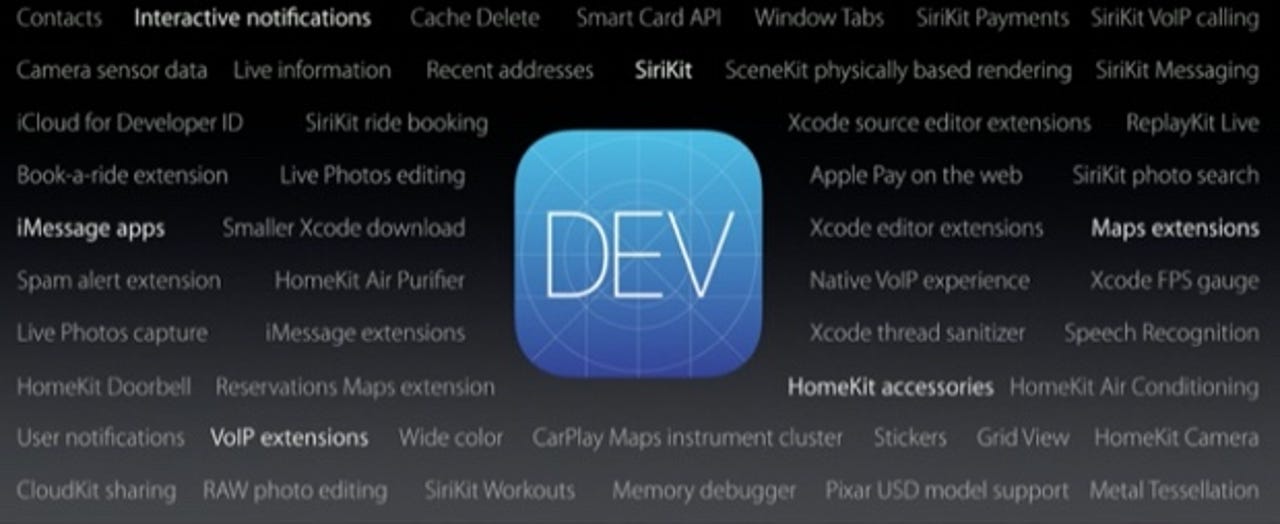Apple WWDC 2016: 12 big takeaways


Developers are going to take an even bigger part in shaping iOS 10, macOS and watchOS 3.
#1: Apple Watch is capable of a lot more that the first-gen OS let on
Native apps, instant launch, a dock, a Control Center and so on are now possible. We might have sniggered a bit when we saw the hardware specs of the Apple Watch when it was first unveiled last year, but watchOS 3 is now unlocking features that I think most - outside of Apple - could have dreamt of.
See also: Will your iPhone or iPad run iOS 10?
#2: Apple Watch to become an accessory for Mac users
WWDC 201
So far, the Apple Watch has been an exclusive accessory for the iPhone, but now Apple is extending that by making it a handy Mac accessory, allowing owners to automatically unlock their laptop or desktop without needing a password.
#3: Apple expands its ecosystem with Continuity enhancements
macOS and iOS 10 will break down the boundaries between the different devices, making it easy to start a project on one device and then move to another seamlessly with features such as Universal Clipboard.
#4: Apple is into AI
Apple is tentatively dipping its toe into the AI waters with technologies that can analyze your photos for faces and context - all done locally - and by applying LSTM (Long Short-Term Memory) deep learning technologies to Messaging.
#5: China! China! China! China!
I lost count of the number of times that "China" was said during the keynote. And that's no surprise given how it's soon going to become Apple's biggest market.
#6: iCloud is going to become a much bigger part of macOS
But rather than iCloud being a drive that you have to manually drop things into, macOS will be getting optimized storage features that automatically store old files in the cloud to free up space local drive space (which undoubtedly means more iCloud revenue for Apple).
#7: Messaging gets smarter
We're moving away from text and emojis and getting features such as intelligent suggestions, contact information, intelligent scheduling, calendar availability, recent addresses, and much more. There is also a whole raft of new gimmicks related to emojis, new speech bubbles, invisible ink effects, along with handwriting features such as Digital Touch.
#8: Phone just got smarter
iOS 10 brings new features such as voicemail transcription and phone spam detection, and a new VoIP API for incoming calls lets them look like regular phone calls, and revamped contact cards that are now aware of new services such as WhatsApp.
#9: This is about tweaking the fundamentals as opposed to massive reinvention
If you were expecting a massive amount of reinvention in iOS 10, macOS and watchOS 3 then you're going to be disappointed. This round of upgrades is about taking features from one platform and moving them to another (such as Control Center and the Dock now in watchOS), and revamping existing apps, making more features available from the iOS lock screen, and bringing apps that have been around for years - such as Messages and Phone - up-to-date.
#10: Apple is opening a lot of doors to developers
Siri, Messages, and HomeKit are being opened up to third-party developers, which will allow for a whole raft of new and exciting apps for both iOS and macOS. Rather than having to have more and more features baked into the operating system - inevitably adding to bloat - users can instead choose the functionality they want to add by downloading the relevant third-party app.
#11: Privacy
Apple placed a heavy focused on privacy, highlighting the end-to-end encryption for communications that leave the device, and by making AI functionality run locally on the hardware, rather than offloading it into the cloud.
#12: Apple is paving the way for the next generation of programmers
In order to foster the next generation of coders, Apple has developed a new tool called Swift Playgrounds for the iPad to guide users through the process of learning to code. And so that this tool has the widest reach possible, it's going to be free from the App Store.
Essential accessories for your MacBook, MacBook Air and MacBook Pro (June 2016 edition)
See also: